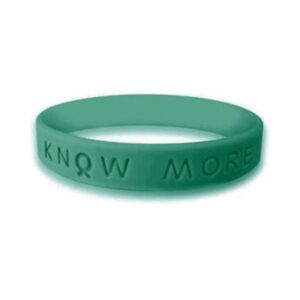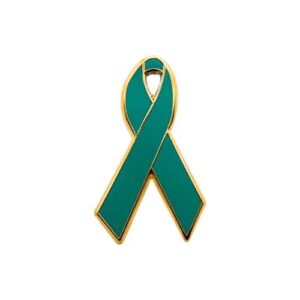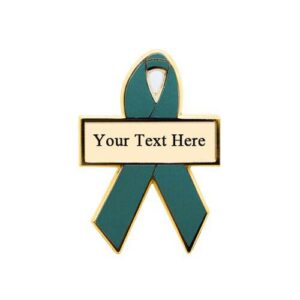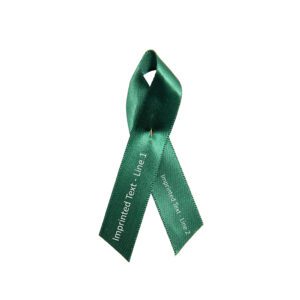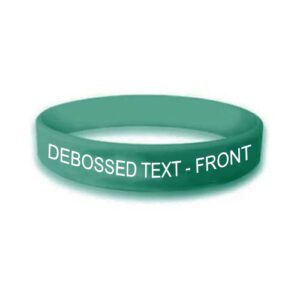Search by Color or Cause
$49.95
Wear your heart on your sleeve with a green fabric awareness ribbon on your lapel.
Shop Personalized Cause for awareness ribbons, pins, and wristbands for over 1000 causes.
Our green cloth fabric ribbons come in bags of 250 pieces (bulk).
Simple awareness ribbons started it all: a global movement for a better tomorrow. Today, an awareness ribbon is an iconic, worldwide symbol of hope for warriors and survivors, alike. For over twenty years, Personalized Cause has been at the forefront of the awareness ribbon movement, and strives to keep abreast of ever-changing awareness color and cause updates. Through this attention to cause awareness, Personalized Cause raises hope, encourages compassion, and highlights medical, social, mental health, autoimmune, and cancer causes. These causes are near and dear to many. Pin a ribbon to your lapel to show support for cancer research fundraisers or group marches for social change,
Personalized Cause has the most up-to-date and comprehensive awareness cause and color reference guide on the internet. Because of that, it has taken years to compile a list that is accurate and inclusive. You can find this extensive cause list under Awareness Ribbons Colors Causes and Meanings | Reference Guide. You can also use the Find Your Product search tool on the Home Page to find the product you’re looking for – search by color or cause.
Grosgrain ribbons primarily contain cotton, polyester and fiber blends. Satin ribbons, on the other hand, primarily contain nylon or polyester. Grosgrain ribbons also have thick horizontal fibers, whereas satin ribbons are smooth to the touch. Satin ribbons are much softer than grosgrain ribbons. Many people love satin ribbons for their beautiful shiny finish, allowing them to create a sleek look.
Double-faced satin ribbon is perhaps the most common type of satin ribbon available. Like the name suggests, this ribbon has two right sides. Therefore, it doesn’t matter what side faces upward or outward, as both of the sides look the same. The alternative is a single faced ribbon, which has a shiny outer side and a muted underside. Our satin ribbons are double-faced.
We offer these green fabric awareness ribbons in bags of 250 pieces. Our ribbons are perfect for fundraising, awareness events, cancer races, awareness campaigns, support groups, school fundraisers, funerals, memorial gifts, and promotional products. Wearing awareness ribbons sends a subtle message that you support a cause. For example, it might mean you are raising awareness for a particular social cause. Another reason to wear a ribbon is to support a medical or mental health cause. Further, perhaps the ribbon represents a cause that personally connects to a cause affecting animals. Again, the ribbon sits on the left side of the chest or over the heart which is symbolic for a cause that is heartfelt.
Please note: We cannot personalize these ribbons. However, click here to see our personalized fabric ribbons in similar colors with an attached safety pin on the back of the fabric ribbon.
Green Awareness Ribbons – Causes, Colors, Meanings and Months:
The primary causes associated with green awareness ribbons are Mental Health, Organ and Tissue Donation, and Certain Cancers.
Mental Health
The color green represents mental health awareness, both in green and lime green. Either ribbon is acceptable to wear in support of mental health.
Lime Green and Green Awareness Ribbons
A lime green ribbon is a universal symbol of advocacy that is worn on a lapel to show support for mental health causes.
The dark green ribbon is the international symbol of mental health awareness. Wearing a green ribbon shows support for those affected by mental health conditions and advocates for positive change. It can also be worn in memory of a loved one.
Mental health causes may include:
Bipolar Disorder (alternate color: Black and White)
Childhood Depression (alternate color: Lime Green)
Childhood Mental Health (alternate color: Lime Green)
Childhood Mental Illness (alternate color: Lime Green)
Depression
Major Depressive Disorder
Mental Health
Mental Health Disorders
Mental Illness
Mood Disorders
Another primary cause associated with green awareness ribbons is Organ and Tissue Donation.
Organ and Tissue Donation
Organ donation occurs when an organ (e.g., heart, lung, kidney) is removed from one person and transplanted into another person. Tissue donation occurs when tissues in the body (e.g., skin, corneas, bone) are removed from one person and transplanted into another person.
Organ and tissue donation causes may include:
Bone Marrow Donation
Living Organ Donation
Organ Donation
Stem Cell Donation
Stem Cell Research
Tissue Donation
Another primary cause associated with green awareness ribbons are certain cancers.
Cancers
Cancer is a disease that occurs when cells in the body grow and divide uncontrollably, forming tumors and potentially spreading to other parts of the body
Cancer causes may include:
Adrenal Cancer
Bile Duct Cancer (Cholangiocarcinoma)
Gallbladder Cancer
Liver Cancer
Another primary cause associated with green awareness ribbons is Climate Change.
Climate Issues
Climate change affects the environment in many different ways, including rising temperatures and sea levels, drought, flooding, fires and more. These changes affect things like water, energy, transportation, wildlife, agriculture, ecosystems, and human health.
Climate change causes may include:
Climate Change, in general
Disaster Relief
Environmental Protection
Natural Disasters, including Hurricanes and Fires
Other Green Ribbon Causes Include:
Bone Marrow Diseases and Failure
Cerebral Palsy
Essential Tremor
Gastroparesis
Genocide (alternate color: Black and Red)
Kidney or Renal Diseases
Liver Diseases
Missing Children (alternate color: Yellow)
Missing Persons (alternate color: Yellow)
Mitochondrial Disease
Muscular Dystrophy
Neural Tube Defects
Reproductive Rights
Scoliosis
Spinal Cord Injury and Research
Sports-Related Chronic Traumatic Encephalopathy
Traumatic Brain Injury / TBI
Von Hippel-Lindau Syndrome
Awareness Months for Green Causes
Adrenal Cancer Awareness Month – April
Bile Duct Cancer (Cholangiocarcinoma) Awareness Month – February
Bipolar Disorder Awareness Month – March
Bone Marrow Diseases and Failure Awareness Month – November
Bone Marrow Donation Awareness Month – November
Cerebral Palsy Awareness Month – March
Childhood Depression Awareness Month – May
Childhood Mental Health Awareness Month – May
Childhood Mental Illness Awareness Month – May
Climate Change Awareness Month – September
Depression Awareness Month – May
Environmental Protection Awareness Month – September
Essential Tremor Awareness Month – March
Gallbladder Cancer Awareness Month – February
Gastroparesis Awareness Month – August
Genocide Awareness Month – April
Kidney or Renal Diseases Awareness Month – March
Liver Cancer Awareness Month – October
Liver Diseases Awareness Month – October
Living Organ Donation Awareness Month – April
Major Depressive Disorder Awareness Month – May
Mental Health Awareness Month – May
Mental Health Disorders Awareness Month – May
Mental Illness Awareness Month – May
Missing Children Awareness Day – May 25
Mitochondrial Disease Awareness Month – September
Mood Disorders Awareness Month – May
Muscular Dystrophy Awareness Month – September
National Missing Persons Day – February 3
Natural Disasters Awareness Month – September
Neural Tube Defects Awareness Month – January
Organ Donation Awareness Month – April
Reproductive Rights Awareness Month – February
Scoliosis Awareness Month – June
Spinal Cord Injury Awareness Month – September
Spinal Cord Injury Research Awareness Month – September
Sports-Related Chronic Traumatic Encephalopathy Awareness Month – January
Stem Cell Donation Awareness Month – October
Stem Cell Research Awareness Month – October
Tissue Donation Awareness Month – April
Traumatic Brain Injury / TBI Awareness Month – March
Von Hippel-Lindau Syndrome Awareness Month – May
WHAT IS THE HISTORY OF THE AWARENESS RIBBON?
In 1979, Penney Laingen’s husband was held prisoner during the Iran hostage crisis. To call attention to this, she placed yellow ribbons on trees in her neighborhood. She also created yellow ribbons for people to wear to show support for her husband and others being held hostage. This was the first time an awareness ribbon was used publicly as a way to silently voice support.
About ten years later, the group Visual AIDS used a bright red ribbon to represent awareness and support for AIDS and the lives lost to it. This trend caught on quickly. Awareness ribbons were so well accepted as a way to demonstrate support, in fact, that the New York Times declared 1992 as The Year of the Ribbon.
That was the same year the pink ribbon became associated with breast cancer. The Susan G. Komen Breast Cancer Foundation (now Susan G. Komen for the Cure) handed out pink hats to breast cancer survivors who participated in their Race for the Cure. Soon after, in 1992, Komen distributed pink ribbons to everyone who participated in the race.
The next big step came later that year. Alexandra Penney, editor of Self Magazine, produced their second annual Breast Cancer Awareness Month issue. This issue was inspired by Evelyn Lauder, Vice President of Estee Lauder. She was also a breast cancer survivor. Alexandra and Evelyn collaborated to create a pink ribbon to distribute in cosmetic stores throughout New York City. This action was so popular that eventually the pink ribbons were placed on cosmetics counters all across the United States during Breast Cancer Awareness Month.
That year, 1.5 million ribbons were distributed. On each one was a card that explained how to do self breast exams. They also collected over 200,000 petitions, asking the White House to provide additional funding for breast cancer research.
The next year, in 1993, popularity grew. Avon joined in the fight for breast cancer awareness and launched a pink rhinestone brooch in the shape of the pink awareness ribbon. In two years, sales from the pin raised over $10 million for breast cancer research. This visibility helped make everyone more aware of the need for research.
Many people believe that because of these awareness ribbons and the visibility they created, federal funding for breast cancer research increased from approximately $100 million in 1991 to over $550 million in 1996. This helped pave the way for pink ribbons and other colors, calling attention to the need for research money for causes such as autism, epilepsy, Alzheimer’s and many more.
Calling attention to various diseases and disorders, as well as social causes, is the impetuous behind awareness ribbons. Showing support and understanding can often make all the difference to those who struggle.
